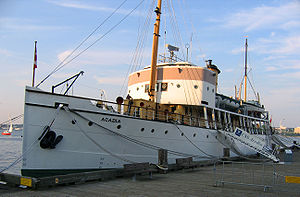CSS Acadia

CSS Acadia preserved as a Museum Ship alongside the wharves of the Maritime Museum of the Atlantic, Halifax, 2007
|
|
| History | |
|---|---|
|
|
|
| Name: | Acadia |
| Builder: | Swan Hunter, Tyne and Wear, United Kingdom |
| Laid down: | 1912 |
| Launched: | May 8, 1913 |
| Commissioned: | as HMCS Acadia January 16, 1917; October 2, 1939 |
| Decommissioned: | March 1919, November 3, 1945 |
| In service: | September 1913 – November 1969 |
| Refit: | New Bridge, Pictou, NS, 1956 |
| Homeport: |
Registered: Ottawa Actual: Halifax & Pictou |
| Fate: | Museum ship, Halifax, 1982 |
| General characteristics | |
| Type: | Hydrographic research ship/auxiliary patrol vessel |
| Tonnage: | 846 GRT |
| Displacement: | 1,050 long tons (1,070 t) |
| Length: | 181 ft 9 in (55.40 m) |
| Beam: | 33.5 ft (10.2 m) |
| Draught: | 19 ft (5.8 m) |
| Ice class: | Ice strengthened |
| Propulsion: | Single shaft, 2 fire tube Scotch boilers, 1 triple expansion steam engine, 1,715 hp (1,279 kW) |
| Speed: | 12.5 knots (23.2 km/h) |
| Boats & landing craft carried: |
4 survey launches, 2 lifeboats, 2 dories |
| Complement: | 15 hydrographic staff |
| Crew: | 50 |
| Armament: |
|
| Notes: | Now a museum ship owned by the Maritime Museum of the Atlantic |
| Official name | S.S. Acadia National Historic Site of Canada |
| Designated | 1976 |
Registered: Ottawa
CSS Acadia is a former hydrographic surveying and oceanographic research ship of the Hydrographic Survey of Canada and its successor the Canadian Hydrographic Service.
Acadia served Canada for more than five decades from 1913 to 1969, charting the coastline of almost every part of Eastern Canada including pioneering surveys of Hudson Bay. She was also twice commissioned into the Royal Canadian Navy (RCN) as HMCS Acadia, the only ship still afloat to have served the RCN in both World Wars. Today she is a museum ship, designated as a National Historic Site of Canada, moored in Halifax Harbour at the Maritime Museum of the Atlantic.
Retaining her original engines, boilers and little-changed accommodations, she is one of the best preserved Edwardian ocean steamships in the world and a renowned example of Canada's earliest scientific prowess in the fields of hydrography and oceanography.
Acadia was designed in Ottawa by Canadian naval architect R.L. Newman for the Hydrographic Survey of Canada and built by Swan Hunter & Wigham Richardson at Newcastle-on-Tyne in England. Named after Acadia, the early colonial name for Atlantic Canada, she was launched on May 8, 1913. Acadia arrived in Halifax on July 8 and was commissioned that July upon her first voyage using the prefix CGS, which stood for "Canadian Government Ship." She saw extensive use prior to 1917 surveying the waters along Canada's Atlantic coast, including tidal charting and depth soundings for various ports. Her first two seasons were spent charting in Hudson Bay at Port Nelson and the entrance to Hudson Bay to open the way for a grain port for Manitoba. In her first year she also made the first Canadian surveys of notorious Sable Island and rescued the crew of the steamship Alette, crushed by ice in Hudson Bay, the first of many rescues the rugged Acadia would make. Among her more enduring work was a survey of the Bay of Fundy which became her longest assignment prior to entering military service in World War I.
...
Wikipedia
